Craft and Textiles
Seasonal Carpet Care: Year-Round Maintenance Tips
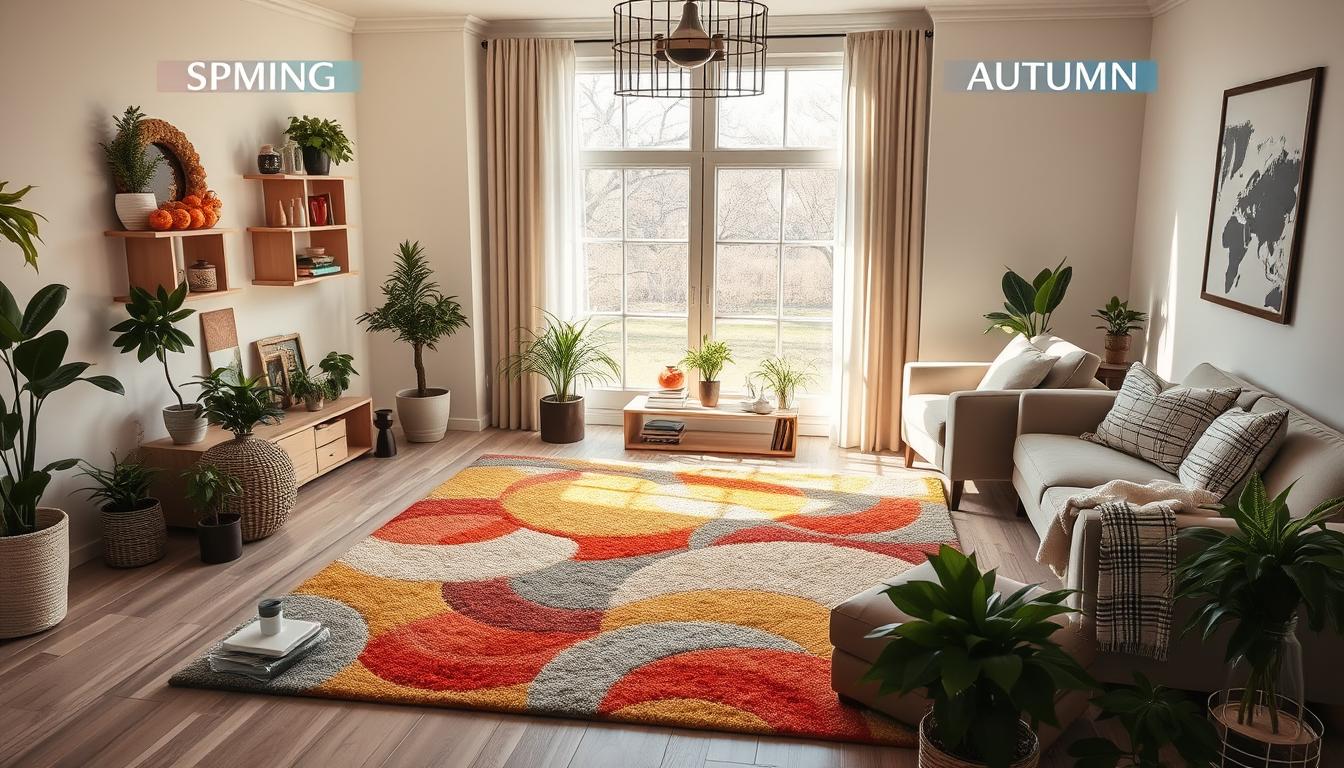
Have you stepped on your living room carpet and felt a rough texture underfoot? This feeling means it’s time for some extra carpet care. Carpets need different care as the seasons change. By following seasonal maintenance, you make your home look better and your carpet last longer. Adjusting how you clean through the year stops damage from moisture, allergens, and dirt. This guide provides key tips for keeping your carpets clean all year. It will help create a healthy and welcoming space for your family.
Key Takeaways
- Understand seasonal challenges to create effective carpet care routines.
- Increase vacuuming during high-traffic seasons to keep carpets clean.
- Schedule professional cleanings to address deep-seated dirt and allergens.
- Prompt spot cleaning can prevent permanent damage to carpet fibers.
- Utilize entry mats and remove shoes to minimize dirt entering your home.
Understanding the Importance of Seasonal Carpet Care
It is key to know how to take care of your carpets for a fresh, clean home. Every season brings different challenges that affect how clean and lasting your carpet is. For example, winter can bring wetness and dirt, and spring might bring allergens that harm indoor air quality. Changing your carpet care with the seasons helps a lot.
When spring comes, vacuum your carpets at least twice a week to fight allergens. A pro deep clean this time of year gets rid of dirt and allergens well. In summer, watch out for humidity. A dehumidifier can stop mold and mildew. Use area rugs or runners in busy spots to keep your carpets looking good.
In fall, it’s important to stop leaves and dirt at the door. Use mats and clean your carpets well to keep them fresh. With winter, more people stay inside. Use mats and trays for shoes to stop salt and dirt from getting on your carpets. Make sure your home is well-ventilated to keep the carpets dry.
All year, a good vacuum cleaner with a HEPA filter is a smart buy. Move your furniture now and then to avoid uneven carpet wear. By adjusting how you care for your carpets with the seasons, you save money and keep your home healthy.
Winter Carpet Care Tips
Winter makes caring for carpets tough, with wetness and dirt posing big problems. A few smart steps can improve how you look after your carpets during the cold months. This keeps your carpets looking great.
Use Entry Mats
Putting mats at all doors helps catch dirt and moisture. They act as a barrier, keeping a lot of the mess out. Pick mats made for lots of use because they grab more dirt. Choose ones that are easy to clean for frequent upkeep.
Remove Shoes Before Entering
Asking people to take off their shoes before coming in cuts down on dirt and salt. This keeps carpets from getting worn and stays clean. Teaching family and guests to do this helps keep your home neat.
Increase Vacuuming Frequency
It’s key to vacuum more in the winter. This removes dirt on the surface and stops deeper grime. Pay extra attention to busy spots. Quickly clean any spills to avoid long-term stains. Cleaning often, plus planning for professional cleaning before and after winter, keeps carpets fresh.
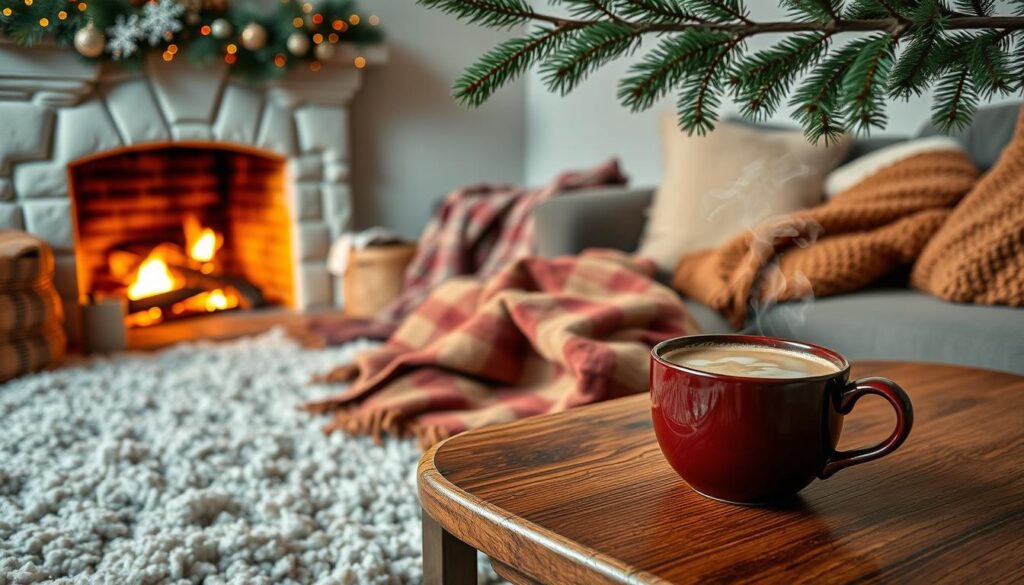
Spring Carpet Care: Revive After Winter
Spring brings a chance to give your carpets a fresh start. After winter, salt, dirt, and moisture have likely gathered in your carpets. A deep clean will not just make them look good but will keep you healthier too.
Deep Cleaning Benefits
Deep cleaning in spring gets rid of allergens and pollutants in your carpets. Using professional services or powerful equipment can reach deep into the fibers. This helps to control allergies by removing pollutants, which is great as pollen levels rise.
Address Allergens Like Pollen
Pollen increases in spring and can get trapped in your carpets, causing allergies. Vacuuming twice a week with a HEPA filter vacuum can help. Also, cleaning carpets this season keeps dust mites and irritants away, making your home healthier.
Utilize Humidity Control
Controlling humidity in spring helps keep your carpets and home feeling fresh. Dehumidifiers lower moisture, which stops mold from growing. This way, your carpets stay clean and smell nice, making your home more comfortable.

Summer Carpet Care: Managing Heat and Humidity
As the summer heats up, keeping heat and humidity in check is key for your carpets. Vacuuming more can help handle the extra dirt from outside. This keeps your carpets fresh and clean all summer.
Enhanced Vacuuming Routine
Vacuum more in places where people walk a lot. This will keep the dust and dirt away. A vacuum with HEPA filters can catch more allergens, making your home healthier.
Use Area Rugs for Protection
Adding area rugs can protect your carpets. They’re easy to clean and protect against sun damage. With the right care, you can prevent mold and keep your carpets looking great. Cleaning up spills quickly is also important for their upkeep.
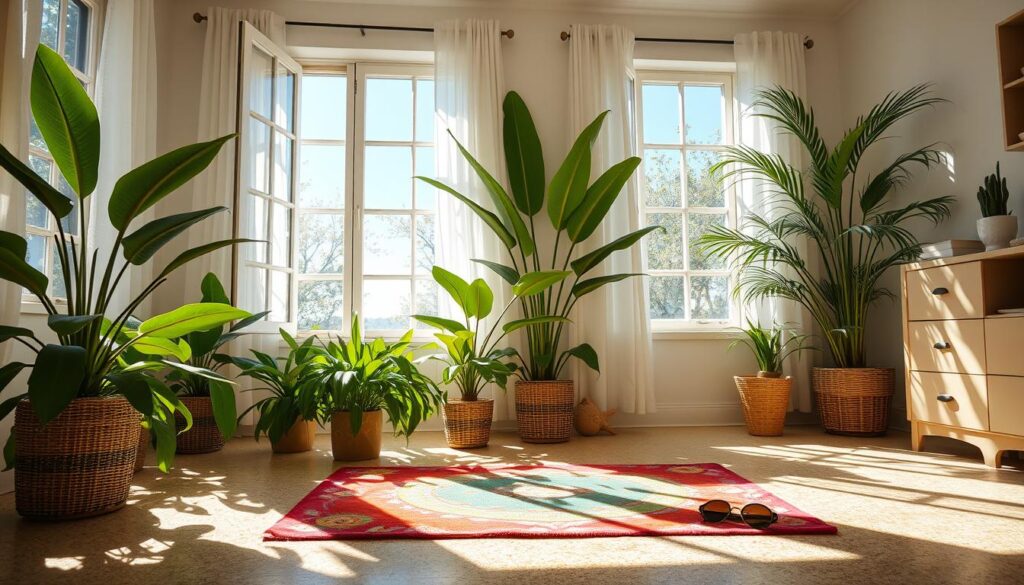
Autumn Carpet Care: Preparing for Inclement Weather
Autumn is here, and it’s time to get your carpets ready for bad weather. Leaves fall and rain increases, so you need good plans for carpet care. Keep your home clean and welcoming by following these tips.
Entryway Preparation
Keeping a clean entryway is key. Use tough mats outside and inside your doors to catch dirt and moisture. Make a rule to take off shoes at the door. It’s a simple action, but it stops most dirt from coming in, helping a lot with the weather changes.
Leaf Management Strategies
Dealing with leaves is important in the fall. By regularly raking and getting rid of leaves, you prevent them from entering your house. Try having a specific spot for leaves to keep your yard neater. This also stops dirt from getting on your carpets and keeps the air in your home cleaner.
Schedule Professional Cleaning
It’s wise to get your carpets professionally cleaned before winter. Early autumn is ideal for cleaning away the dirt that’s built up. A deep clean removes things like pollen and dust. This makes your home healthier for your family.
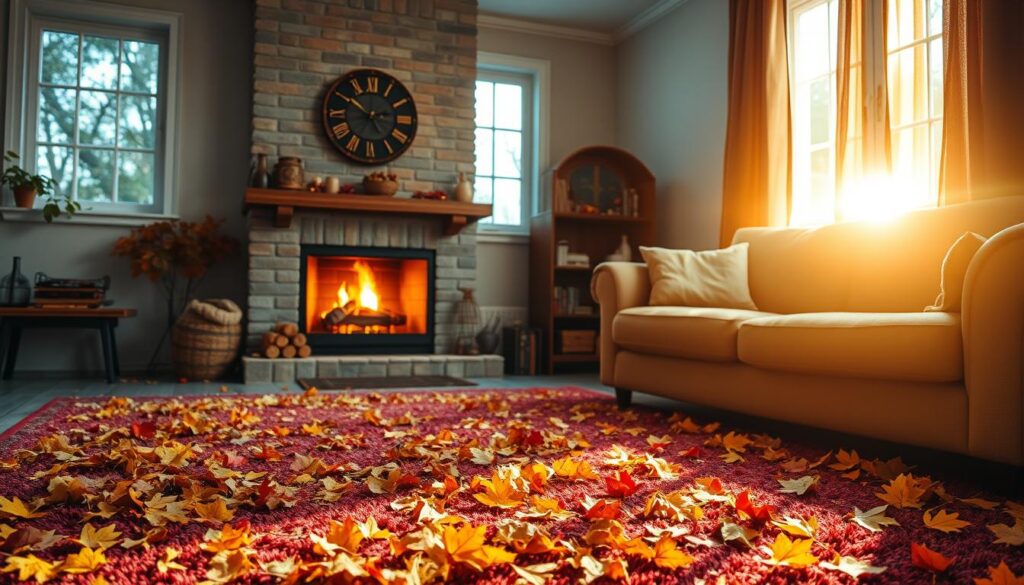
Seasonal Carpet Care: What to Do in Each Season
Changing your carpet cleaning habits with the seasons is key for keeping them looking great. Each season brings different challenges, like spring’s moisture or winter’s snow. By adapting your carpet care for each season and sometimes getting professional help, you can keep your carpets in top shape.
Adjusting Cleaning Routines
In the summer, the heat can make your carpets fade and get dirty faster. This means you should vacuum at least twice a week. Spring moisture can cause mold, so it’s important to clean your carpets well to remove winter’s grime.
Identifying Seasonal Challenges
- Winter: Snow and rain often bring wet shoes and potential damage to rugs.
- Spring: Increased humidity fosters an environment for mold and mildew.
- Summer: Dust mites thrive in warmer conditions, increasing allergens.
- Autumn: The shift in foot traffic can lead to more dirt and potential stains.
Incorporating Professional Help
When carpet cleaning seems too much to handle, professional cleaners can be a big help. Companies like Wizard Cleaning offer deep cleaning with special equipment for any season. They keep your carpets in great shape, fighting wear and tear and improving the air in your home. Getting your carpets professionally cleaned regularly can really help make them last longer and stay cleaner.

Year-Round Carpet Maintenance Techniques
To keep carpets looking great all year, you need a plan. Use regular vacuuming, spot cleaning, and moving furniture around. These steps keep your carpets in top shape. They make your home look better and help keep the air clean.
Regular Vacuuming Essentials
Make vacuuming part of your weekly routine. Focus on busy areas every week. In spring, do a deep vacuum to get ready for summer. This keeps your home clean and cuts down on allergens in the carpet.
Spot Cleaning Procedures
When spills happen, clean them up fast. Use the right cleaners to avoid stains. Quick action keeps your carpets looking new and saves you work later.
Furniture Rotation Tips
Don’t forget to move your furniture now and then. Shifting things around stops carpets from getting dents and worn out spots. This simple move can make your carpets last longer and look even.
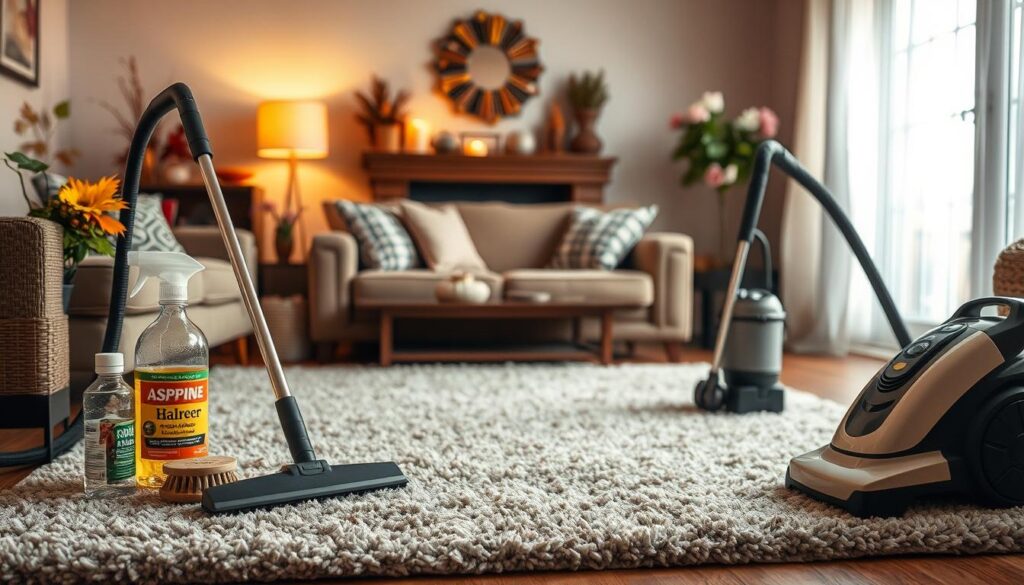
| Maintenance Technique | Frequency | Benefits |
|---|---|---|
| Vacuuming | At least once a week in high-traffic areas | Removes dirt and dust, improves air quality |
| Spot Cleaning | As spills occur | Prevents permanent stains |
| Furniture Rotation | Every 6 months | Prevents uneven wear |
Signs Your Carpet Needs Professional Cleaning
Knowing when your carpet needs cleaning helps keep your home fresh and healthy. Look for stains, smells, and wear in busy areas. These signs mean you can avoid spending too much on replacement or using the wrong cleaning methods.
Visible Dirt and Stains
Seeing visible stains that won’t go away with usual cleaning means you need expert help. Regular vacuuming can’t get rid of all the dirt. If you have kids or pets, think about getting a professional clean every six months.
Odors and Allergens
It’s important to pay attention to odors to keep the air in your home clean. Trapped moisture or allergens might be causing bad smells. Hidden nasties like mildew, dust, or pet fur can harm your air quality. Getting your carpets professionally cleaned regularly will take care of these problems.
Wear and Tear on High-Traffic Areas
Carpet wear in busy spots shows its true condition. This wear can make your home look less inviting. A professional clean now and then keeps your carpets looking good and lasting longer.
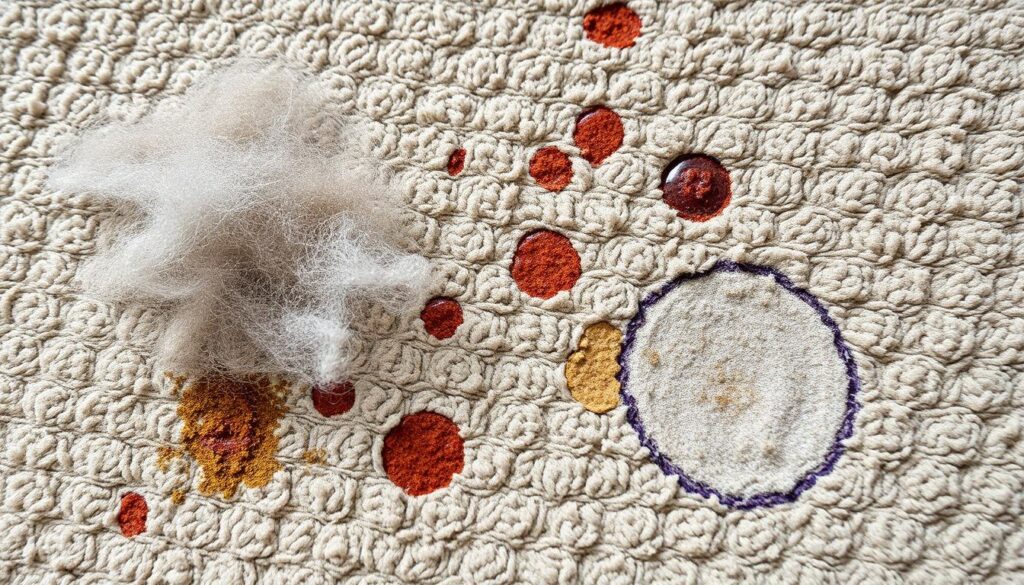
| Signs | Recommended Action | Frequency |
|---|---|---|
| Visible Dirt and Stains | Schedule professional cleaning | Every 6-12 months |
| Odors | Deep cleaning to remove allergens | At least once per year |
| High-Traffic Carpet Wear | Professional maintenance | Every 6 months if necessary |
Being proactive about carpet cleaning not only makes your home look better. It also makes it a healthier place to live.
Choosing the Right Carpet Cleaning Service
Finding the perfect carpet cleaning service keeps your carpets looking great. It’s about weighing different factors to ensure excellent care. Look at what each company offers, as services and skills can vary. Decide what’s best based on what you need.
Evaluating Services Offered
Check what carpet cleaning services are up for grabs. Choices range from intensive cleanings, caring for your furniture, to improving your air quality. Think about what your carpet needs and the setup of your home. And don’t forget to ask about eco-friendly choices!
Understanding Cleaner Certifications
Before choosing, learn about the cleaner’s certifications. Certified pros usually have training from well-known places. It means they’re ready for all kinds of carpets and messes. Knowing they’re educated in cleaning methods makes you feel good about having them over.
Assessing Reviews and Recommendations
It’s essential to read reviews and get recommendations. Feedback gives you the inside scoop on the quality, timing, and happiness of customers. Look at the company’s site and other review spots for a full picture. What others say can really help you decide.
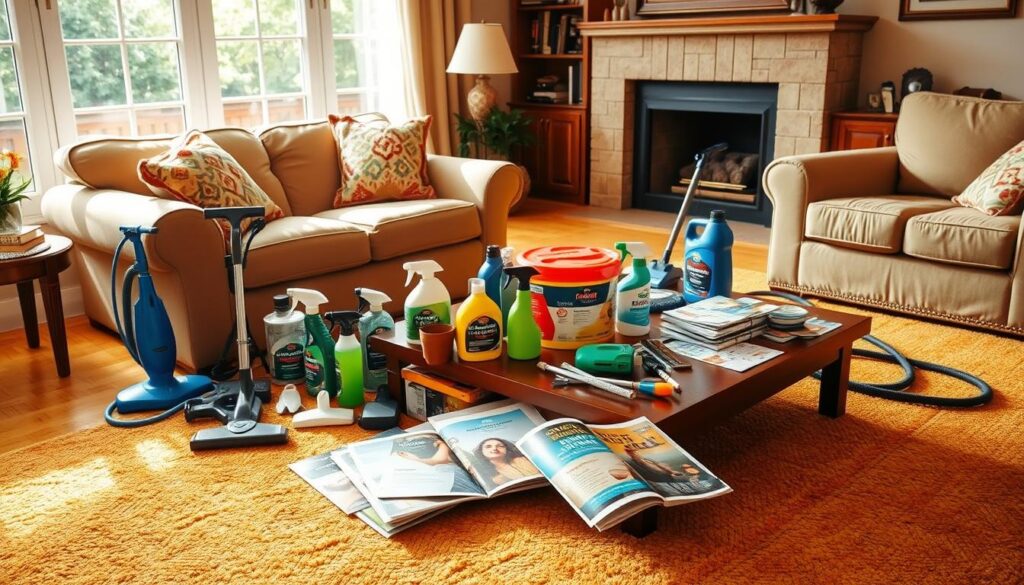
DIY Carpet Care Tips
DIY carpet care helps you keep carpets clean while saving money. You can use simple kitchen ingredients for eco-friendly cleaning. This approach makes carpet maintenance both affordable and green.
Homemade Cleaning Solutions
Making your own cleaning solutions is easy. You only need a few household items, for example:
- Vinegar and water: Mix equal parts to remove stains and odors.
- Baking soda: Baking soda lifts moisture and odors when sprinkled before vacuuming.
- Dish soap: A tiny bit with water can get rid of grease stains.
Use these DIY methods to keep your carpets clean and fresh.
Routine Maintenance Practices
Regular maintenance is key to keeping carpets lasting longer. Here are some tips:
- Frequent vacuuming: Vacuum at least twice a week, especially where people walk the most.
- Spot cleaning: Quickly clean spills with homemade solutions to avoid permanent stains.
- Area rugs: Protect high-use areas with rugs to lessen dirt and wear on carpets.
Following these steps will help maintain your carpets, keeping them looking great for years.
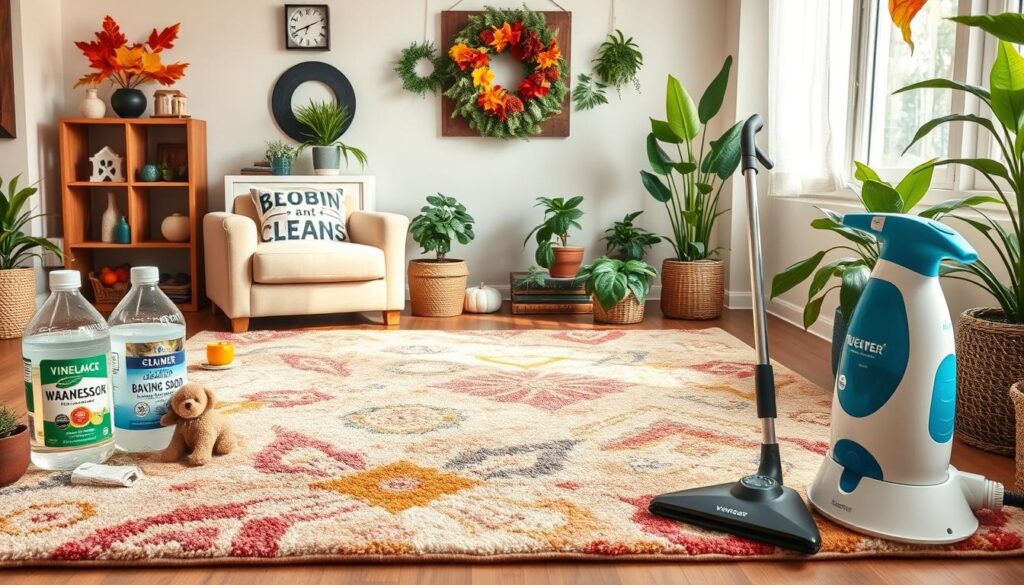
Conclusion
Keeping your carpets clean needs a smart plan that changes with the seasons. Winter brings the challenge of moisture and salt. Summer adds problems with allergens and dirt. By changing how you look after your carpets all year, you keep them looking and smelling fresh. This also helps your carpets last longer.
Vacuuming often, especially in areas that see a lot of foot traffic, is key. Use the right vacuum filters. Also, getting professional cleaners to help at least twice a year is important. Using baking soda can fight off allergens, making your home healthier. Don’t forget to move your furniture now and then to avoid uneven carpet wear. Use coasters under furniture to protect your carpets.
Having a cleaning plan that matches each season’s needs means your carpets will always be in great shape. They show off your style and make your home welcoming. With the right care for each season and regular upkeep, your carpets can stay clean and beautiful all year long.
FAQ
Why is seasonal carpet care important?
How often should I vacuum my carpets during winter?
What are some effective ways to manage allergens in the spring?
How can I prevent fading of my carpets in summer?
What steps should I take for autumn carpet maintenance?
How can I tell if my carpets need professional cleaning?
What DIY solutions work best for minor carpet stains?
How do I choose the right carpet cleaning service?
Is rotating furniture necessary for carpet maintenance?
Can professional cleaning remove allergens effectively?
Mason – Your Product Expert Mason is your go-to product expert, carefully selecting each item in our collection to ensure it meets your comfort, functionality, and style needs. With his attention to detail and commitment to quality, he ensures that every product we offer enhances your home experience.
Craft and Textiles
Moisture-Resistant Basement Carpet Selection Guide

Have you ever walked into your basement and felt the cold damp air? Or smelled mildew that made the space less inviting? You’re not alone in wanting a cozy basement for friends to gather or for solo relaxation. The right carpet is key, not just for looks but to fight humidity and moisture too. Thanks to new technology, certain carpets can make your basement comfy and safe from water damage. Let’s dive into the choices for basement carpets in this detailed guide.
Key Takeaways
- Basements are typically the most humid areas in a home.
- Synthetic carpets, especially Triexta, are highly recommended for their moisture resistance.
- Low-pile carpets are easier to maintain and help reduce moisture retention.
- Carpet tiles provide easy replacements and flexibility for basement flooring.
- Proper ventilation and moisture-resistant padding are crucial for carpet longevity.
Understanding the Importance of Choosing Carpet for Basements
Choosing the right flooring for your basement is very important. Basements face unique challenges that other parts of the house don’t. Carpets are key for a healthy home. They trap dirt, pollen, and other allergens. They also absorb sound, making the basement quieter.
Carpets make basements more comfortable. They feel soft and warm underfoot, perfect for areas that get a lot of use. Durable carpets also insulate against the basement’s cold. This turns a chilly room into a warm, welcoming space.
Basements can get water damage and mold. The right carpet can lower these risks. Nylon and polyester are good because they resist moisture. Also, many carpets come with warranties. This protects your money if something goes wrong.
Basements can be anything from playrooms to guest spaces. With different carpet options, you can style them any way you like. You can choose from lots of colors and styles. Go for neutral shades for flexibility or bold colors for a pop.
Knowing the advantages of basement carpets helps you make smart choices. The right carpet can make your basement a favorite spot in the house. With the right care, your basement carpet will last and keep looking great.
Pros and Cons of Basement Carpeting
Looking at the pros of basement carpet, you’ll find many benefits. Carpets make the space warm, bringing comfort to usually chilly areas. They also lower noise, perfect for homes with kids or lots of activity. This means you won’t hear echoes from hard floors, giving you a calm sound setting.
Another plus is how carpets help with allergens. They catch dust mites and pet hair, making the air better for those with allergies. Big names like Shaw Floors and Mohawk Industries have moisture-resistant carpets. These are great for basements, keeping them safe from spills or dampness.

However, there are downsides to basement carpeting. The biggest issue is moisture. Basements can be damp, and carpets might hold onto this moisture. This can lead to mold and mildew, so you need to watch and care for carpets regularly.
Cleaning these carpets can be tough. Dirt and moisture can build up fast. Often, you’ll need more than just vacuuming. Choosing a type of carpet, like low-pile, helps make cleaning easier and drying quicker if there’s water damage.
| Pros of Basement Carpet | Cons of Basement Carpeting |
|---|---|
| Provides warmth and comfort | Susceptible to moisture damage |
| Reduces noise and echo | Challenges in cleaning and maintenance |
| Helps manage allergens | Potential for mold and mildew growth |
| Moisture-resistant options available | May require professional deep cleaning |
| Budget-friendly carpet choices | Needs regular monitoring and care |
The Role of Moisture in Basement Environments
Basements are prone to basement moisture due to being below ground. High humidity can cause mold and damage floors. It’s vital for homeowners to know these risks to keep their basements safe.
Effects of humidity on basements are major. Moisture can get through concrete, causing mold to grow. This mold harms air quality and can be expensive to fix. It’s important to control moisture to keep your basement healthy.
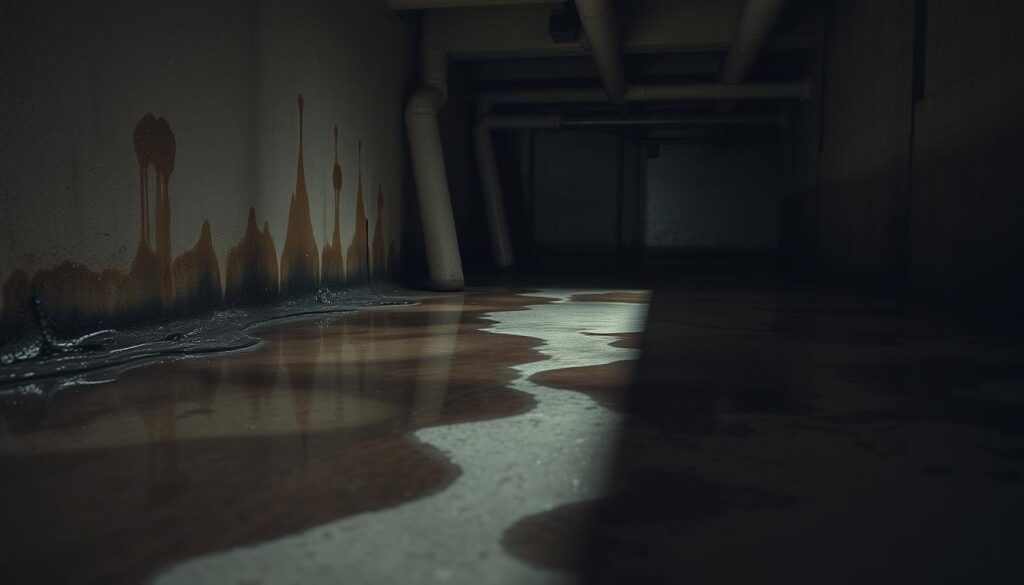
To fight moisture, there are good steps to take. Adding better ventilation lowers humidity, which helps prevent condensation. Dehumidifiers also help by keeping the basement dry.
Here’s a list of ways to control basement moisture:
| Moisture Control Method | Description | Benefits |
|---|---|---|
| Improved Ventilation | Enhances air circulation to reduce humidity. | Decreases condensation and air quality issues. |
| Dehumidifiers | Devices that remove excess humidity from the air. | Maintains optimal humidity levels for comfort and protection. |
| Proper Drainage | Ensures water flows away from the foundation. | Reduces risk of water seepage and flooding. |
| Window Well Maintenance | Fill window wells with aggregate to prevent water pooling. | Avoids water collecting around windows, minimizing leaks. |
Using these methods can greatly cut down basement moisture. This keeps your home safe and comfy.
How to Choose the Perfect Carpet for Your Basement: Moisture-Resistant Options
When picking a carpet for the basement, think about its ability to handle moisture. First, check how humid your basement is. Use a hygrometer to understand the air’s moisture. This will guide you in choosing materials that resist dampness well.
Assessing Your Basement’s Humidity Levels
Your basement can easily get moist, so keep an eye on its humidity. Check for moisture signs and use dehumidifiers to control the air. Make sure air flows well, using windows or vents. This helps stop mold and keep your carpet in good shape.
Identifying Potential Leakage and Flooding Risks
Look for leak risks in your basement before picking a carpet. Check if walls or floors have cracks that might leak water. Use sump pumps and seal walls to protect against floods. These actions help your carpet last longer.

Types of Carpet Fiber: Which is Best for Your Basement?
Choosing the right carpet fiber for your basement is key. Basements have unique conditions, like moisture and humidity. This is why synthetic fibers are the top pick. They handle these conditions well.
Synthetic Fibers Overview
Synthetics like nylon, polyester, Triexta, and olefin resist moisture well. This makes them perfect for underground areas. They keep water away and are durable. Unlike wool, which soaks up moisture, they reduce mold and mildew risk.
Comparing Nylon, Polyester, Triexta, and Olefin
| Fiber Type | Durability | Moisture Resistance | Stain Resistance | Cost |
|---|---|---|---|---|
| Nylon | High | Moderate | Moderate | Higher |
| Polyester | Good | High | Good | Budget-friendly |
| Triexta | Very High | Excellent | Excellent | Moderate |
| Olefin (Polypropylene) | Good | Very High | Fair | Budget-friendly |
Triexta and olefin are great for basements because they handle moisture well. Triexta also resists stains and is good for entertainment spaces. Nylon is tough and durable. But, it’s not the best against moisture. Polyester works well in places that don’t get much foot traffic and is less costly.
Focus on moisture resistance when choosing basement carpets. This choice not only looks good but also keeps the space healthy and comfortable.
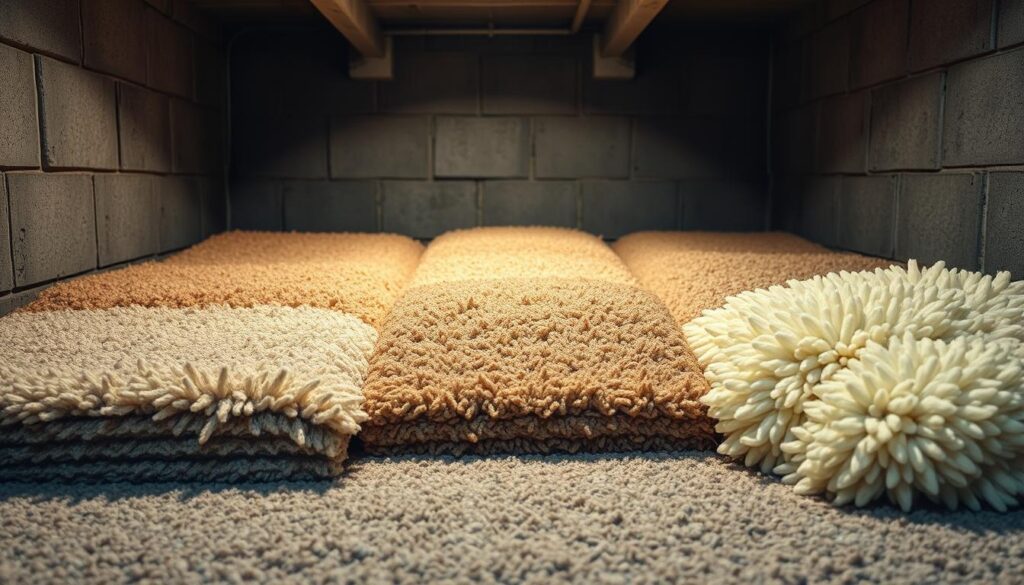
Importance of Low Pile Carpets in Basements
Choosing the right carpet for your basement matters a lot. The height of the carpet’s pile plays a big role in its function and upkeep. Low pile carpets are best for basements. They handle basement challenges well.
Benefits of Low Pile Carpets
Low pile carpets bring many pluses, especially in basements which can get wet. They’re easy to clean with their short fibers that don’t hold much dirt.
These carpets also let air move better. This helps keep dampness down. They stay looking good even in busy spots because they don’t get flattened easily.
Popular Low Pile Carpet Options for Basements
There are many good low pile carpets for basements. Berber carpets are tough. They handle water well, making them a smart choice. Olefin is another choice that’s easy to keep up and fights water.
Triexta carpets feel plush and also resist moisture well. They’re great for basement spots designed for fun.
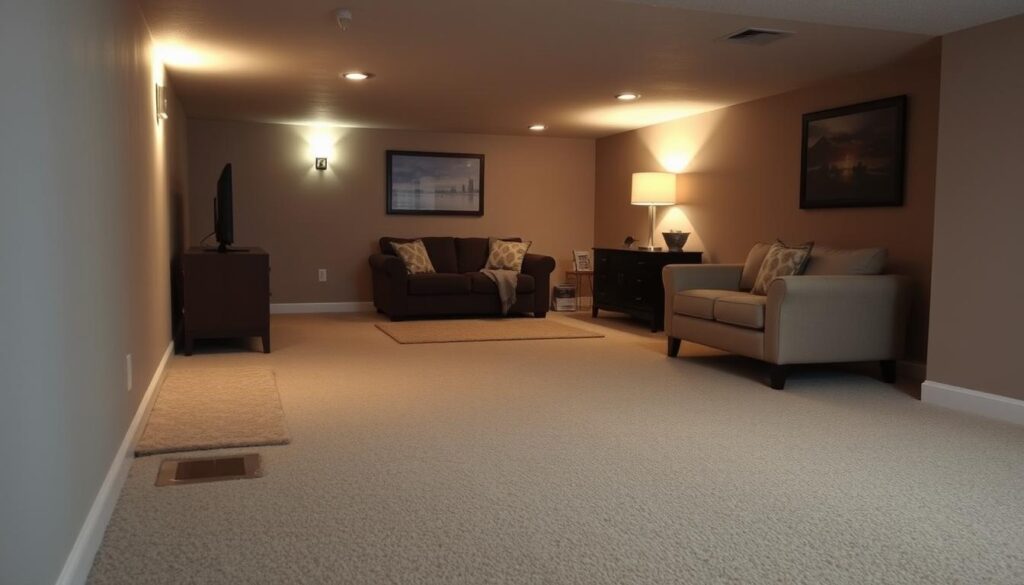
The Advantages of Using Carpet Tiles
Carpet tiles are a smart and practical choice for basements. They last longer than regular carpets, especially in busy areas. This makes them perfect for basements where foot traffic is common.
These tiles are also easy to keep clean with just a simple vacuum. They resist water, which helps keep mold and mildew away. If they get stained or damaged, you can just replace the affected tiles. This saves you from having to replace your whole floor.
Carpet tiles are also a budget-friendly option. Since you can swap out single tiles, you waste less and save money. Plus, their design lets you be creative, letting you mix and match to style your basement your way.
They help keep your basement warm and quiet, too. Because they’re designed to fight moisture, you won’t have as much trouble with mold or mildew. And there’s a wide range of colors and textures for you to choose from, so you can really make the space yours.
Installing carpet tiles is easy, with many types just needing to be peeled and stuck down. This DIY friendliness can help you save on installation costs. Carpet tiles offer both function and style for your basement flooring.

| Advantage | Description |
|---|---|
| Durability | Last longer than traditional carpets, suitable for high-traffic areas. |
| Easy Maintenance | Simple vacuuming keeps the tiles clean, easy to replace damaged pieces. |
| Cost-Effectiveness | Replace single tiles instead of the entire floor reduces repair costs. |
| Moisture Resistance | Less susceptible to mold and mildew, ideal for basement conditions. |
| Customization | Available in various designs, allowing for a unique basement aesthetic. |
| Insulation | Provide thermal and acoustic benefits for enhanced comfort in your basement. |
Selecting the Right Padding for Basement Carpets
Choosing the correct carpet padding boosts comfort and durability for your basement carpets. Basements can be damp, making it vital to pick moisture-resistant padding. This type of padding keeps moisture in check. It helps keep your carpet in top shape for a longer time.
Types of Carpet Padding
There are many carpet padding types, each with unique perks. Here’s a glance at some common choices:
| Padding Type | Weight (lbs per cubic foot) | Advantages |
|---|---|---|
| Rebond Foam | 5-10 | Good value, made from recycled foam, commonly used in residential settings. |
| Frothed Foam | 12+ | Highly durable and comfortable, great for long-term use. |
| Flat Rubber | 18-22 | Best option for durability; provides excellent moisture resistance. |
| Waffle Rubber | Less than Flat Rubber | More affordable, but less durable than flat rubber padding. |
Moisture-Resistant Padding Benefits
Moisture-resistant padding has many benefits for your basement carpet. Some key advantages include:
- Prolonged Carpet Life: Carpets lose thickness faster without proper padding. Tests show carpets without padding lost 19.3% in thickness. This is compared to only 5-10% with padding.
- Mold Prevention: This padding stops mold growth, a big issue in basements.
- Comfort: Quality padding makes your basement feel more comfortable.
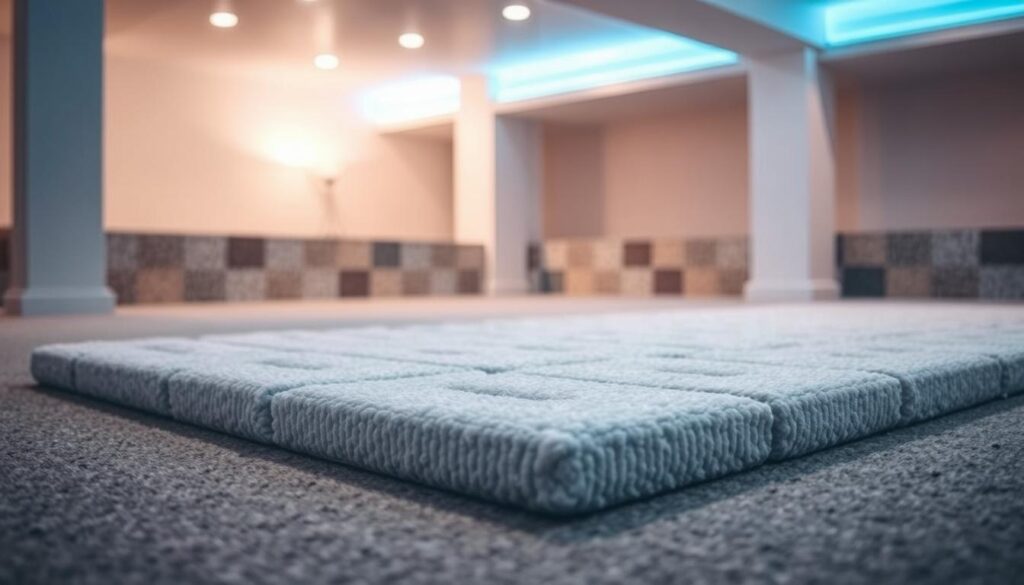
Pick carpet underlay ranging from 3/8 to 1/2 inch thick. Moisture-resistant padding not only elevates comfort but also blocks the cold. As you look for carpet padding, focus on those that manage moisture well. This will keep your basement healthy and comfy.
Best Practices for Maintenance and Care of Basement Carpets
Maintaining your basement carpets well takes consistent work. Regular care keeps your floors looking great and fights moisture problems. With the right cleaning methods, your carpets can stay in top shape, even in a basement.
Regular Cleaning Techniques
To keep your carpets lasting longer, make a cleaning plan that includes:
- Weekly Vacuuming: Vacuum at least once a week. Pay extra attention to areas with a lot of foot traffic.
- Deep Cleaning: Do a deep clean twice a year using hot water extraction or a steam cleaner. It’s great for getting rid of allergens and stubborn dirt.
- Carpet Treatments: Think about using treatments like Green Guard for added durability and spill protection.
Dealing with Stains and Spills
Act quickly when something spills to remove stains best. Here’s what to do:
- Blotting: Gently dab the stain with a clean cloth. Don’t rub to avoid spreading the stain.
- Cleaning Solutions: Pick a cleaner that’s right for your carpet’s material. Nylon and polyester work well with water-resistant treatments.
- Rinsing: After cleaning, rinse the spot with water and blot it dry to get rid of any left-over cleaner.

Following these maintenance tips will keep your basement carpets looking their best. Taking early action on cleaning and stains safeguards your investment. It also makes your home healthier.
Conclusion
Choosing the right basement carpet depends on understanding your space’s needs. A good choice looks at moisture-resistance, fiber types, and padding. Use synthetic fibers like nylon, polyester, olefin, and triexta for durability and comfort.
Opt for low-pile and moisture-resistant carpets to boost your basement’s look and make cleaning easy. Products like Mohawk’s Nylon carpet or SmartStrand made from triexta are great options. These choices balance function with luxury, whether you choose sectioned or full-room carpets.
In conclusion, pick a carpet that fits your way of life and your basement’s requirements. Having the right info helps turn your basement into a warm, stylish spot. Think about what you really need and decide wisely. You’ll be happy with your choice for many years.
FAQ
What is the best type of carpet for basements?
How can I assess the humidity levels in my basement?
What are the key benefits of carpeting a basement?
How do I prevent mold and mildew in my basement carpet?
Are carpet tiles a good choice for basements?
What type of carpet padding should I use for a basement?
How can I maintain my basement carpet?
What are the cons of carpeting a basement?
What should I do if I notice signs of water leaks in my basement?
Mason – Your Product Expert Mason is your go-to product expert, carefully selecting each item in our collection to ensure it meets your comfort, functionality, and style needs. With his attention to detail and commitment to quality, he ensures that every product we offer enhances your home experience.
Craft and Textiles
Steam Mops vs Traditional Mops: The Ultimate Guide
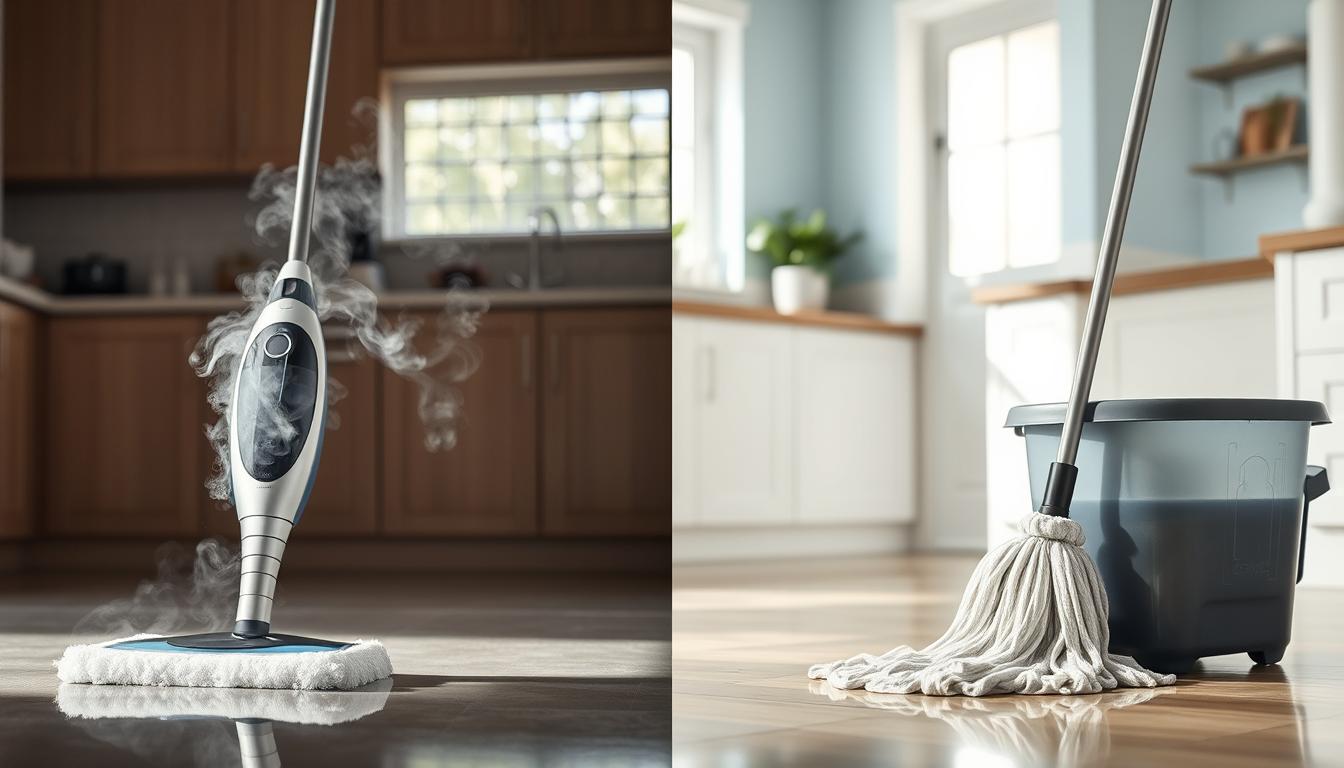
Imagine your feet on a freshly mopped floor, its shine reflecting a productive day. This moment is like a small, peaceful break in our busy lives. Choosing the right mop, steam or traditional, can change how you clean. Your choice affects how fast you clean, mop upkeep, and even how comfy you are while cleaning. This guide highlights each mop’s pros and cons, helping you decide better. Your choice could change how you clean entirely.
Key Takeaways
- Understanding the unique features of steam mops can enhance your cleaning efficiency.
- Traditional mops provide simple but effective solutions for everyday messes.
- Choosing the right mop depends on your specific cleaning needs and preferences.
- Steam mops might require a higher initial investment but can save time and effort.
- Both mop types have their merits; the right choice can lead to a cleaner, more comfortable home environment.
Understanding the Basics of Floor Cleaning
Choosing the right floor cleaning method is crucial for a good outcome. Different methods are made for different surfaces and problems. For example, there are mop types like string mops, good for soaking up liquids, and flat mops, better for hardwood floors. Each kind offers unique benefits for various cleaning tasks.
In 2022, the market for manual cleaning mops in the U.S. was worth $448.50 million. It’s expected to grow to $522.51 million by 2028. This shows people still prefer traditional cleaning methods for their daily use.
Not all surfaces are cleaned the same way. Spin mops work well on big areas with tiles or laminate. Sponge mops are better for gentle surfaces. Then, there are microfiber mops. They remove up to 99.5% of dirt and germs. That’s much more effective than cotton mops, which only pick up 67% of dirt and germs.
Steam mops use hot steam to kill bacteria on floors, offering a deeper clean. But, you must be careful with the type of floor you use them on. Hardwood and laminate might get damaged. Knowing these differences helps in picking the best cleaning method for your needs.
What is a Steam Mop?
A steam mop is a clever cleaning tool. It cleans floors using steam. It turns water into hot steam at about 248 degrees Fahrenheit. This steam helps break down dirt and grime. It’s a great way to clean without harsh chemicals, making it perfect for those who prefer not to use them.
How Steam Mops Work
Steam mops use hot steam from water. The steam comes through microfiber mop heads. It easily breaks down dirt and stains. The steam helps lift grime and also disinfects your home’s surfaces. Tests showed they can handle different messes, like crayon and soda, often in 2 to 5 swipes.
Benefits of Using Steam Mops
Steam mops have lots of pluses. They are efficient and easy to use. Some benefits include:
- Speed: They clean quickly, needing fewer passes.
- Deep Cleaning: The hot steam lifts dirt and sanitizes.
- Chemical-Free Cleaning: They’re great for families, cutting out chemical cleaners.
- User-Friendly: They’re designed to help people who have trouble moving. This makes floor cleaning easier.
The PurSteam 10-in-1 Steam Mop was a top performer in tests. It’s noted for its strong steam and good price. The Shark S7001 Rotating Steam Mop was also highly rated, especially for cleaning kitchens. AENO models offer various features, like many nozzles and a shoulder strap. This makes them versatile for different cleaning tasks.
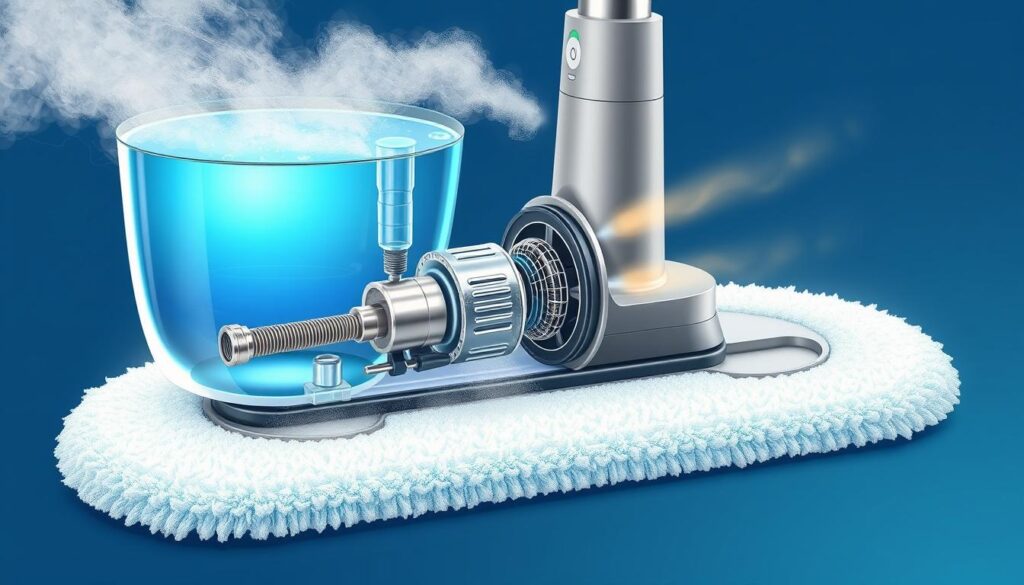
| Steam Mop Model | Tank Capacity | Cleaning Time | Special Features |
|---|---|---|---|
| PurSteam 10-in-1 | N/A | N/A | Versatile cleaning capabilities |
| Shark S7001 | N/A | N/A | Rotating mop head |
| AENO SM2 | 275 ml | 24 minutes | Shoulder strap, various nozzles, 3 steam modes |
| AENO SM2 | 380 ml | 35 minutes | Shoulder strap, various nozzles, 3 steam modes |
What is a Traditional Mop?
A traditional mop is one of the most common tools for floor cleaning. It’s different from steam mops as it needs manual effort and cleaning solutions to get rid of dirt and grime. Knowing the various kinds of traditional mops will help you pick the best one for your cleaning tasks.
Types of Traditional Mops
There are many mops to choose from, including:
- Cotton Mops: These classic mops are made of absorbent cotton. They are great for everyday cleaning and are usually the most pocket-friendly.
- Spin Mops: They have a wringing feature that makes removing extra water easier. They are handy and lessen the effort needed for mopping.
- Flat Mops: Flat mops have a rectangular head and use microfiber pads. They are perfect for cleaning hardwood and tiles easily across big spaces.
Advantages and Disadvantages
Traditional mops have their own ups and downs:
| Pros | Cons |
|---|---|
| Highly cost-effective and widely available. | High manual effort required, which can be tiring. |
| Compatible with all flooring types if used correctly. | Potential for dirt to be spread around if not rinsed properly. |
| No need for electricity or batteries, making them easy to use. | Often relies on chemical solutions for effective cleaning. |
| Lightweight and easy to store. | Cleaning effectiveness may vary based on the user’s technique. |
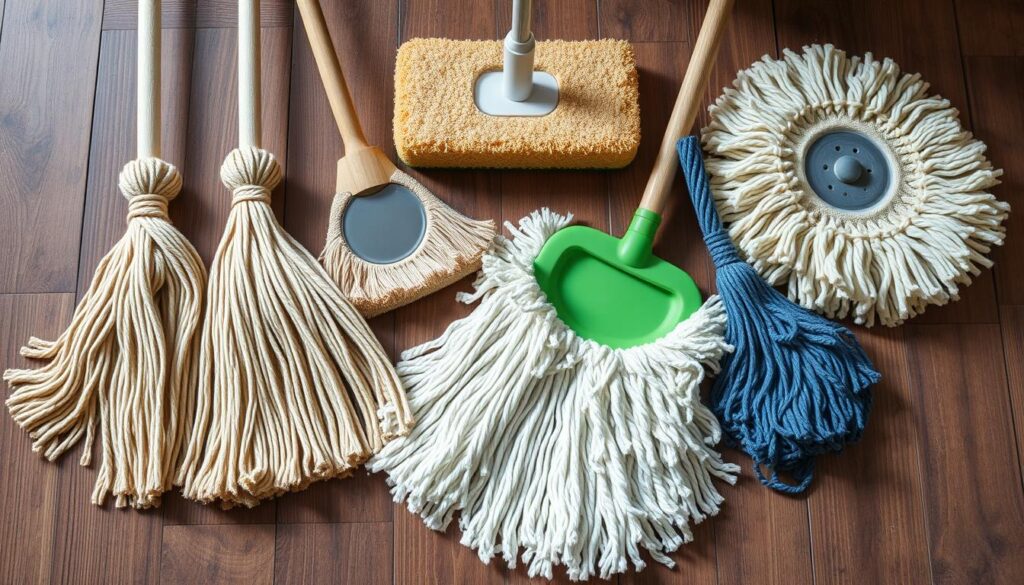
Ultimate Guide to Choosing Between Steam Mops vs Traditional Mops
When you’re stuck deciding between steam and traditional mops, think about what you need. Think about what kind of floors you have and how big your place is. This will make choosing the right mop easier.
In the US, more people are choosing steam mops for a clean without chemicals. They’re great because they use hot steam to fight dirt, which is perfect if you have kids or pets. Plus, they’re good for those who clean a lot and want their home germ-free.
There are many types of traditional mops, like spin, sponge, and flat mops. Spin mops are great because they’re easy to wring out. Sponge mops work well on floors like hardwood. Flat mops are liked for their quick-dry pads and how well they clean.
To pick the best mop, look at what cleaning problems you have. Think about these factors:
- What kind of floors do you have? Some mops are better for certain types.
- How often do you clean your floors?
- Steam mops use less water, making them more eco-friendly.
- Do you need a mop that cleans more than floors?

Look at all these points to choose the best mop for you. It’s not just about cleaning. It’s about finding the right mop for your life and cleaning needs.
| Feature | Steam Mops | Traditional Mops |
|---|---|---|
| Water Usage | Low water usage, more sustainable | Higher water usage |
| Cleaning Ability | Effectively sanitizes with heat | Variety of options for different surfaces |
| Floor Compatibility | Can be used on various surfaces | Dependent on mop type (e.g., sponge for delicate) |
| Convenience | Quick and easy to use | Can require more effort |
| Maintenance | Regular cleaning of mop head needed | Varies by mop type |
Looking closely at these aspects helps make choosing easier. This ensures your cleaning method is both powerful and efficient.
Cleaning Performance Comparison
Choosing between steam mops and traditional mops means looking at how they clean. Each kind uses unique solutions and methods that affect dirt removal. Steam mops are popular for their ability to fight grime and leave floors almost dry. We’ll compare how each type of mop cleans.
How Each Mop Tackles Dirt and Grime
Steam mops use hot steam to remove stubborn dirt. The Bissell steam cleaner heats up fast and cleans sticky spills easily. On the other hand, traditional mops like string mops might not get all the dirt out. They can trap bacteria and may need more cleaning solution.
Stain Removal Capabilities
Getting rid of stains is important for mop performance. Steam mops use heat to loosen stains well, such as jelly or grease spots. The Dupray Neat Steam Cleaner is great at dealing with tough messes. Traditional mops might not remove stains well without extra scrubbing. Steam mops usually do better than regular mops at cleaning various surfaces.

Water Usage and Drying Time
Knowing how much water different mops use and how long they take to dry is key for better floor care. Steam mops often work better because they leave floors less wet and clean well. Traditional mops, on the other hand, leave more moisture. This can make floors slippery, which is risky in homes with lots of activity.
Wetness Left Behind with Each Mop Type
Steam mops, like the FLOOR ONE S5 and S7 models, make floors less wet. They are safer and clean better because of this. Bucket mops use more water and need more time to dry floors. Steam cleaners are great because they leave floors drier, making them safer and cleaner.
Time Taken for Floors to Dry
Drying time is important when picking a cleaning tool. Steam mops, such as those in the FLOOR ONE series, dry floors fast because they are hot. You don’t have to wait long to enjoy clean floors. But, traditional mops keep floors wet for longer because they hold more water. Steam mops are better for homes with kids or pets because they dry floors faster. This means fewer slips.
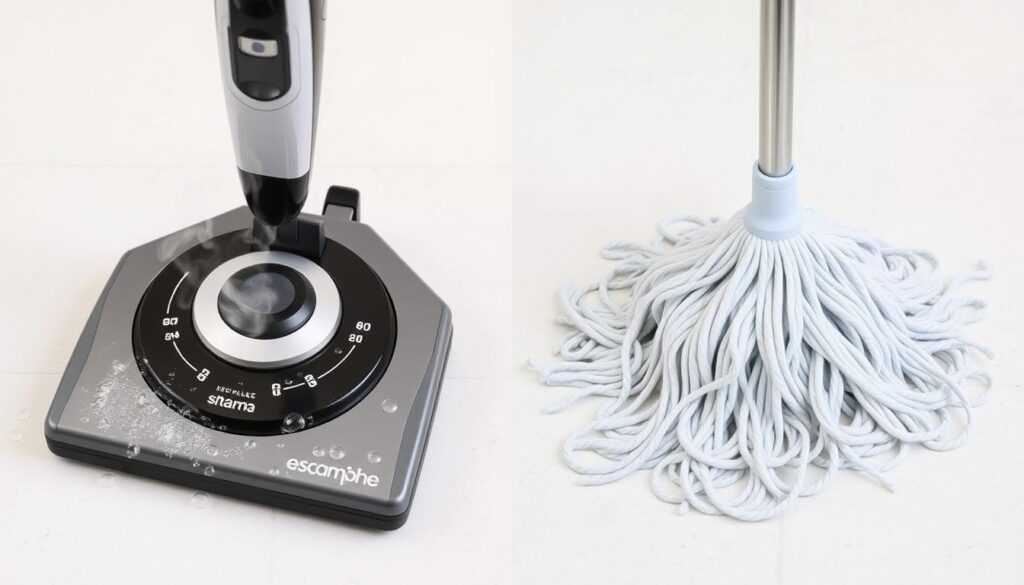
Convenience and Ease of Use
Mops come in different kinds, each with its own benefits. You’ll see how steam mops and traditional mops differ greatly. These differences affect how you use them, from setting them up to how they operate.
Setup and Operations for Each Mop
The Nexlev Steam Mop Swipe starts quickly, taking just 20 seconds to heat up. This lets you clean your floors fast. It also has a 400ml water tank, so you don’t have to keep refilling it.
On the other hand, traditional mops like spin and flat mops need you to do a bit more work. They often need you to wring them out or prep them, which takes up time. Even though they clean many surfaces well, they need more effort to use, especially when changing or refilling water.
Weight and Maneuverability Factors
The weight of a mop greatly affects how easy it is to handle. Steam mops are lighter, so they’re simpler to push around. This is great for anyone who might find a heavier mop hard to use. For example, the H2O X5 mop is easy to move over different floors without much effort.
Traditional mops, like sponge and flat mops, tend to be heavier. Some people might like the heavy feel, but it can make moving the mop harder, especially in small spaces.
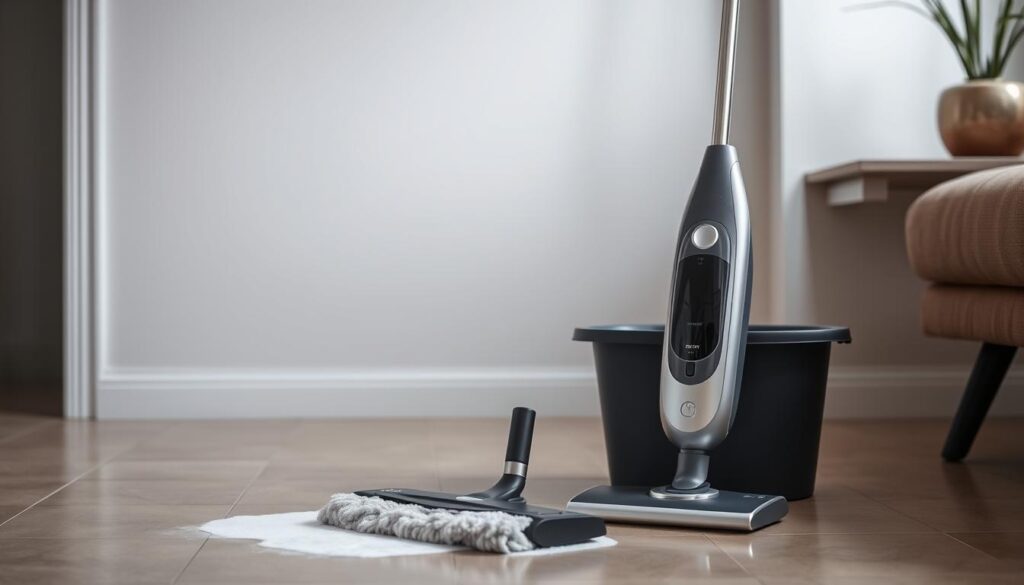
To conclude, steam and traditional mops offer unique benefits. Steam mops make cleaning easier with their quick start and light weight. Traditional mops are good for various tasks but might need more work to use.
Compatibility with Different Floor Types
Choosing the right mop for your floors is important. Different mops work well on certain surfaces. Knowing this helps you pick the best cleaning method. Steam mops and traditional mops have their own strengths. These depend on what kind of floor you have.
Steam Mop Compatibility Considerations
Steam mops are great for certain floors. They do well on:
- Ceramic tiles
- Porcelain tiles
- Linoleum surfaces
These floors can handle the heat and dampness from steam mops. This makes them perfect for kitchens and bathrooms. But, be careful with unsealed wood and laminate. Steam might harm these floors. Always check what the floor manufacturer says before using a steam mop.
What to Know About Traditional Mops and Floor Types
Traditional mops work on many kinds of floors. Let’s look at how they match up with different surfaces:
| Mop Type | Best Suited For | Notes |
|---|---|---|
| Spin Mop | Tile, laminate | Efficient water removal, fast drying |
| Flat Mop | Hardwood, laminate | Excellent floor contact and cleaning |
| Sponge Mop | Hardwood, laminate | Gentle on surfaces, effective at soaking spills |
| String Mop | Textured surfaces, large areas | High absorbency, ideal for commercial use |
| Dust Mop | All surfaces | Effectively attracts and holds dust |
Every traditional mop type has special benefits. This lets you choose the best one for your floor’s needs. Traditional mops can clean many kinds of floors well. This helps keep your floors clean and in good shape.

Cost Analysis: Steam Mops vs Traditional Mops
Choosing the right mop means looking at your wallet. It’s about the cost at the start, how much it costs to keep it going, and how much you might save over time. These points help you spend wisely and get good value for your money.
Initial Investment Overview
The first cost you face is different for steam and traditional mops. Spray mops vary in price from $20 to $300. This depends on the brand and what features it has. For instance, the Rubbermaid Reveal Spray Mop starter kit might set you back around $30. And, you’ll pay between $5 and $20 for each replacement pad.
Steam mops are usually more expensive at the start. Their prices can begin at $40 and go up to more than $200 for the top models. Despite the high start price, steam mops could save you money in the long run. They clean well and cut down on the need for cleaning chemicals.
Long-term Cost Considerations
It’s smart to think about the running costs of each mop type too. Steam mops use less water and don’t need cleaning products. That means lower costs as you go. They last several years if you take care of them well. This could mean more savings when you compare them to traditional mops. Traditional mops need new pads and refills pretty often.
The next table shows what you might spend at first and over time for different mops:
| Mop Type | Initial Cost (Approx.) | Operating Costs (Per Year) | Lifespan (Estimated) |
|---|---|---|---|
| Spray Mop | $20 – $300 | $30 – $60 (pad replacements) | 1 – 5 years |
| Steam Mop | $40 – $200 | Minimal (no pads, water only) | 3 – 10 years |
Both kinds of mops can make your floors sparkle if you take care of them. Looking at upfront costs versus potential savings helps you choose the best option for your home.

Hygiene and Sanitization
Keeping your floors clean is all about hygiene and getting rid of bacteria. Steam mops are becoming more popular because they kill up to 99.99% of bacteria, viruses, and germs. They do this without needing extra detergents. This makes them great not just for homes but for medical places too.
How Effective is Each Mop at Killing Bacteria?
Steam mops are really good at cleaning floors. They get super hot, over 300 degrees Fahrenheit, killing germs well. Traditional mops, however, use chemicals to try and do the same job. But these chemicals might not get rid of all bacteria and can leave stuff behind that’s not clean.
To keep things extra hygienic, use clean microfiber cloths for windows and change out plastic shower curtains often.
Environmental Impact of Cleaning Methods
Choosing cleaning tools also means thinking about the environment. Steam cleaning is better for the planet because it cuts down on harsh chemicals. Steam cleaners can also adjust their water use and be refilled to reduce waste. Yet, steam mops are electronic, which means they can add to e-waste, a growing concern.
For those who care about the earth, finding a mop that is both effective and green is key. This balances cleanliness with taking care of our world.
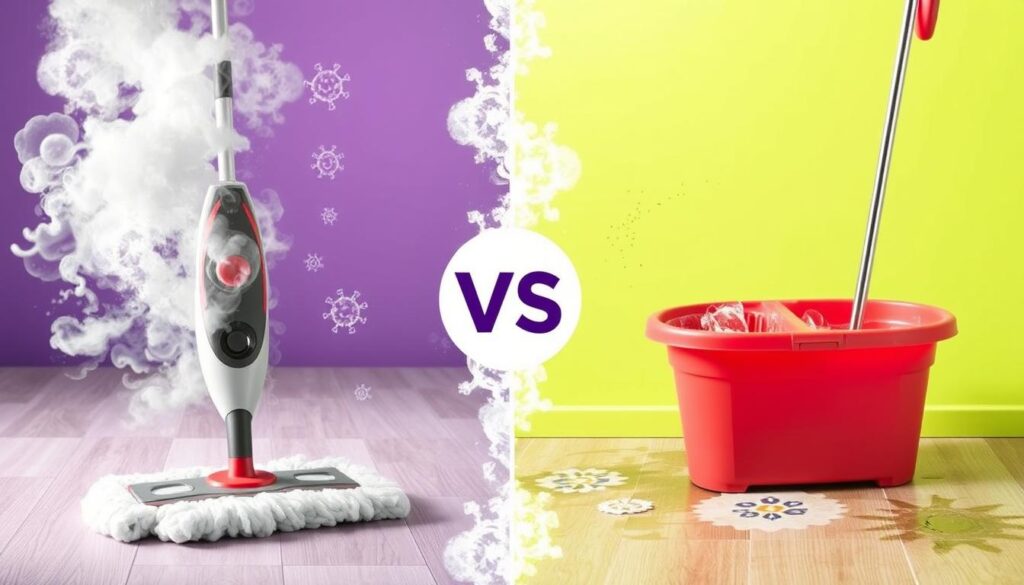
| Cleaning Method | Bacteria Elimination Efficiency | Environmental Impact |
|---|---|---|
| Steam Mop | Up to 99.99% | Low chemicals, potential e-waste |
| Traditional Mop | Varies (depends on chemicals) | Higher chemical usage |
Using the right tools for keeping things clean can make your home healthier. It’s important to think about how your cleaning choices affect the planet too. Choosing between steam mops and traditional mops can help keep things clean and green.
Comparison of Maintenance Requirements
It’s important to know how to maintain your cleaning tools. This helps them last longer and work better. We’ll look at how to take care of steam mops and traditional mops. The focus is on keeping them ready for use.
How to Care for Your Steam Mop
To keep your steam mop in top shape, follow these tips:
- Descaling: Remove mineral buildup by descaling your steam mop. Use hard water? Follow the manufacturer’s guidelines to do it right.
- Pad Washing: After using your mop, wash the pads. This keeps them clean and effective. You can wash some in machines and others by hand.
- Proper Storage: Keep your steam mop in a place that’s cool and dry. Don’t leave water in the tank. It helps your mop last longer.
Maintaining a Traditional Mop
Caring for a traditional mop also needs attention:
- Regular Washing: Clean your mop heads often. This gets rid of dirt and germs, making the mop clean better.
- Replacement of Mop Heads: When mop heads get old, replace them. This keeps your cleaning effective.
- Cleaning Solutions: Choose cleaning solutions carefully. Avoid strong chemicals that might harm your floors. Sometimes, natural options work just as well without harming.
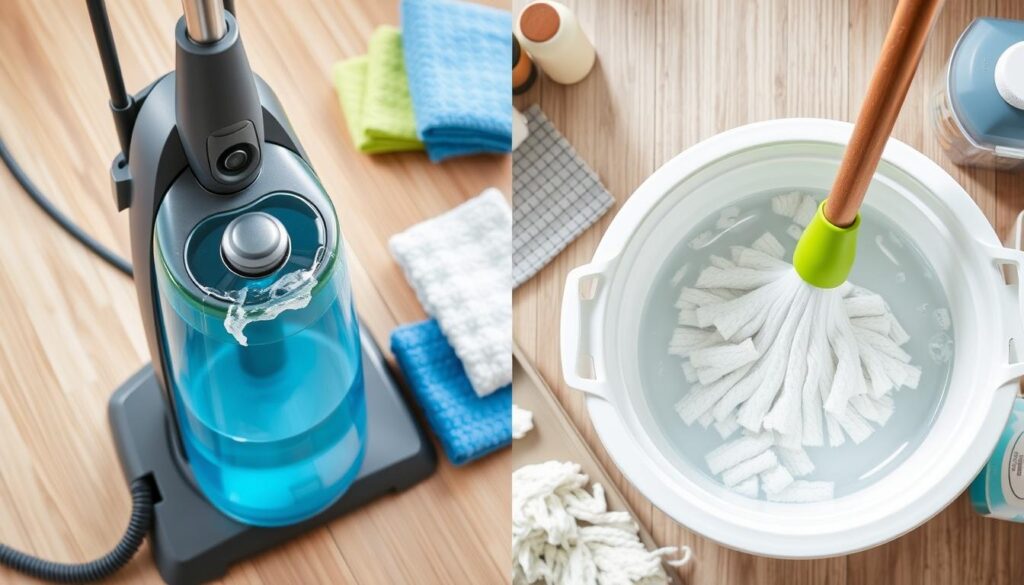
Consumer Satisfaction and Reviews
Your choice in cleaning tools is greatly influenced by consumer satisfaction and reviews. Understanding other people’s experiences with steam mops and traditional mops can guide your decision. Here, we will examine steam mop reviews and feedback on traditional mops to help you understand user preferences.
What Users Say About Steam Mops
Steam mop reviews highlight their effectiveness in cleaning thoroughly. Many users like how they remove hard stains, dirt, pet hair, and muddy footprints. They’re especially pleased with cleaning large areas, like grout in old homes. One person shared how they refreshed 10-year-old grout in a home with five cats.
- Best Overall: Bissell 1940 PowerFresh Steam Mop, priced at $92 with a 15-ounce water tank.
- Best Budget: Shark Steam Pocket Mop, praised for being lightweight at 2.2 pounds and affordable at $64.
- Best for Grout: A steam mop weighing 2.9 pounds, it’s powerful for cleaning various floor types.
People prefer mops that save time and are easy to use. The top steam mop for laminate floors has three steam levels. Some found it hard to set up at first. But, many say cleanup is much quicker with it than traditional mops once you get the hang of it.
Feedback on Traditional Mops
In reviews of traditional mops, ease of use is often praised. Many like their simple design and how light they feel. But, people say they don’t remove tough stains well. This leads many to switch to steam mops, even though they cost more.
- Traditional mops take more effort and time, which people don’t prefer.
- Some stick with traditional mops for daily cleaning but admit steam mops do better.

Comparing user experiences with steam and traditional mops can guide you in choosing the right cleaning tool.
Conclusion
When thinking about choosing a mop, it’s important to see that each type has its own pros and cons. For those who want a deep clean with just water, steam mops like the Keromee MS-100 are great. They heat up fast with a 1200W system and can hold a lot of water. They’re also good for different floor types and can clean without chemicals, which is perfect for homes with kids and pets.
Traditional mops, like spin and sponge mops, have their benefits too. Spin mops are best for cleaning big spaces, and sponge mops are better for softer floors. What mop you choose depends on what you need for your home, how often you clean, and your budget.
The perfect mop depends on what you need. If you want to avoid chemicals, a steam mop might be best. If you prefer something simpler, a traditional mop could work. Think about what fits your cleaning habits best. Choose the mop that makes cleaning easy for you.
FAQ
What is the main advantage of using steam mops over traditional mops?
Can steam mops be used on all types of flooring?
How do I decide whether to buy a steam mop or a traditional mop?
How effective are steam mops at removing tough stains?
What maintenance do steam mops require?
Are traditional mops effective for all kinds of dirt?
What are the long-term cost implications of using steam mops?
How do steam mops compare to traditional mops in terms of drying time?
What do customer reviews typically say about steam mops?
What are some common types of traditional mops?
Mason – Your Product Expert Mason is your go-to product expert, carefully selecting each item in our collection to ensure it meets your comfort, functionality, and style needs. With his attention to detail and commitment to quality, he ensures that every product we offer enhances your home experience.
Yarn
Yarn for Scarves: How Many Yards Do You Need?
Curious about scarf knitting yardage? Discover how many yards of yarn you need for a scarf to start your project with confidence.
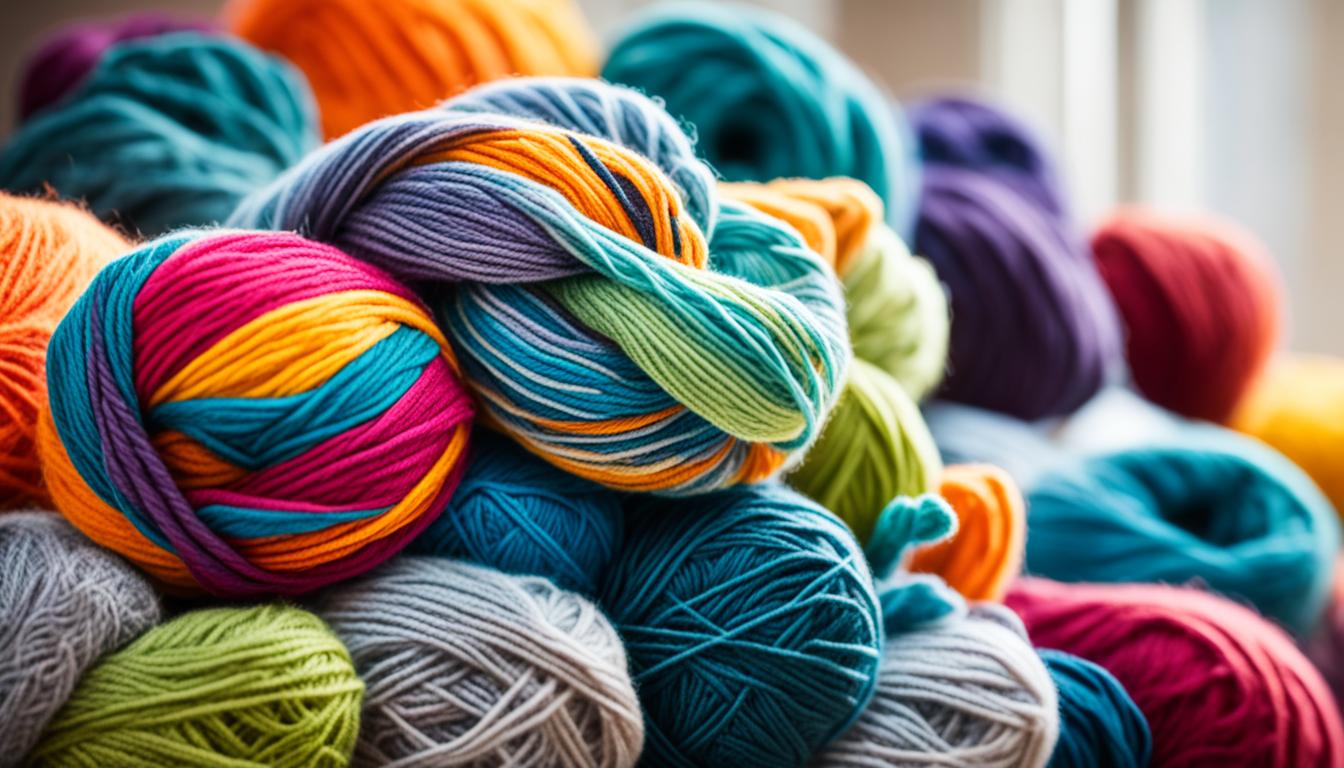
Scarves are a staple accessory for the winter season, keeping us warm and stylish. But have you ever found yourself puzzled when it comes to figuring out how much yarn you need for a scarf? Fear not! We’ve gathered information from various sources to help you calculate the yardage needed for your scarf knitting project. So, whether you’re a beginner or an experienced knitter, join us as we unravel the mystery of yarn requirements for scarves.
Key Takeaways:
- Calculating the yardage for a scarf involves considering factors such as width, length, and texture.
- Understanding yarn weight and yardage is crucial in estimating the amount of yarn needed for a scarf.
- A gauge swatch helps determine the number of stitches and rows per inch, leading to a more precise estimation of yarn requirements.
- Factors like the depth of texture, yarn density, and modifications to the pattern can affect the overall yardage.
- Buying a little extra yarn, using leftover yarn creatively, and considering recommended scarf lengths and widths can optimize your yarn usage.
Understanding Yarn Weight and Yardage
The weight of the yarn is a crucial factor when estimating the yardage required for your scarf knitting project. Different yarn weights will dictate the amount of yardage needed, so it’s essential to refer to a yarn weight chart or the information provided on the yarn label. This will give you a better understanding of the estimated yardage for each weight category.
Lighter yarn weights generally require fewer yards, while heavier weights may necessitate more yardage for the same scarf dimensions. It’s important to consider this variation when calculating the amount of yarn you’ll need for your project.
Calculating Yarn Requirements with Gauge Swatch
When it comes to knitting a scarf, accurately calculating the yardage needed is crucial for a successful project. To achieve this, we recommend creating a gauge swatch. This small sample of knitting helps determine the number of stitches and rows per inch, allowing you to estimate the total yardage required for your desired scarf size. By taking into account your knitting tension and stitch pattern, you can achieve a more precise yarn measurement.
Here’s how to calculate yarn needs using a gauge swatch:
- Start by knitting a small swatch using the same yarn and needle size you plan to use for your scarf.
- Measure the swatch’s width and height, ensuring it’s flat and not stretched. This will give you the number of stitches and rows per inch.
- Determine the desired width and length of your scarf.
- Multiply the number of stitches per inch by the desired width to calculate the total number of stitches needed.
- Multiply the number of rows per inch by the desired length to calculate the total number of rows needed.
- Using the yarn weight and yardage information on the label, estimate the number of yards required per stitch and per row.
- Finally, multiply the total number of stitches by the number of yards per stitch, and multiply the total number of rows by the number of yards per row. Add these two results together to determine the total yardage needed for your scarf.
Calculating yarn requirements with a gauge swatch ensures you have a more accurate estimate, taking into account your unique knitting tension and stitch pattern. This helps prevent the frustration of running out of yarn or having excess leftovers.
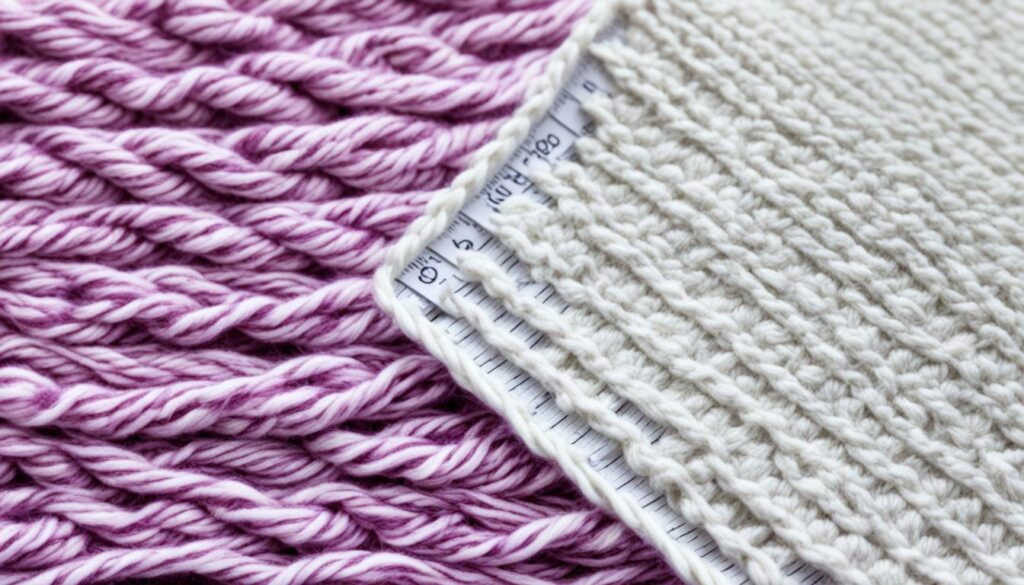
Now that you know how to calculate yarn needs using a gauge swatch, you can confidently start your scarf knitting project. In the next section, we will explore the various factors that can affect the quantity of yarn needed for a scarf.
Factors Affecting Yarn Quantity
When estimating the yardage needed for a scarf, it’s important to consider various factors that can influence the overall quantity of yarn required. These factors include:
- The width and length of the scarf: A wider or longer scarf will naturally require more yarn. This is because the dimensions of the scarf directly contribute to the total surface area that needs to be covered. Therefore, the larger the dimensions, the more yardage will be needed.
- The depth of texture: Adding unique textures to your scarf, such as cables or intricate stitch patterns, can impact the amount of yarn used. These textured elements require more yarn to create the desired effect. So, if you plan on incorporating complex stitch patterns or rich texture in your scarf, be prepared to increase the estimated yardage accordingly.
- The density of the yarn: The density of the yarn, which refers to its thickness and weight, can also affect the yardage needed. Yarns with higher density will require fewer yards to cover the same area compared to lighter-weight yarns. So, if you’re working with a denser yarn, you might need less yardage to achieve the desired size and thickness of your scarf.
To summarize, factors such as the width and length of the scarf, the depth of texture, and the density of the yarn can all influence the total yardage needed for your next scarf-knitting project. Considering these factors and making appropriate adjustments to your estimates will ensure that you have enough yarn to complete your scarf without running out in the middle of your knitting journey.
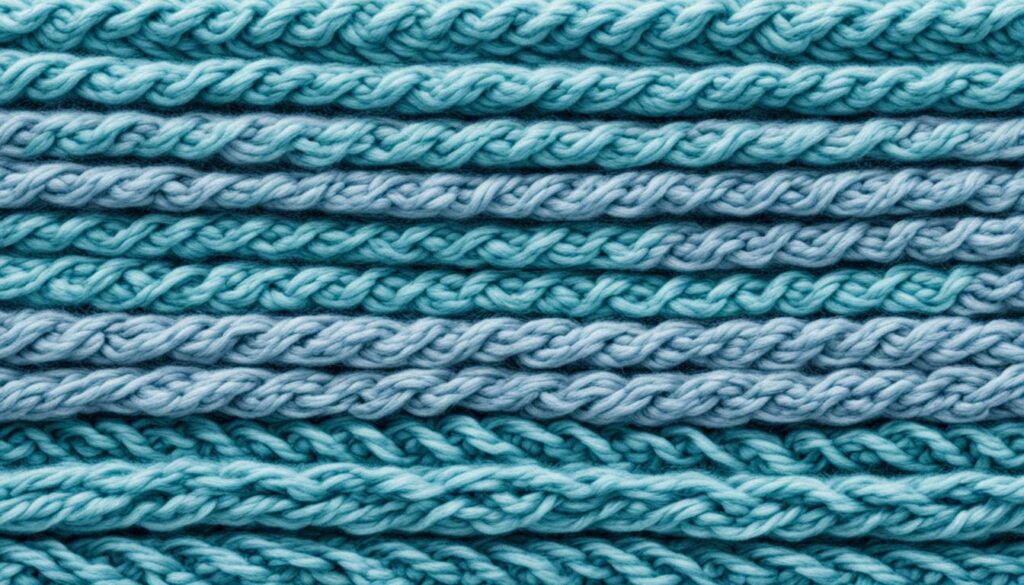
Examples of Yardage Requirements for Scarves
When it comes to knitting scarves, knowing the yardage requirements is crucial to ensure you have enough yarn for your project. To give you a clearer idea of the amount of yarn needed, here are some examples based on specific patterns and measurements:
Example 1: Ribbed Scarf
This simple ribbed scarf pattern calls for 400 yards of worsted weight yarn. With its classic design and versatile style, this scarf is a staple for any winter wardrobe. Knitting it with a cozy yarn will keep you warm and stylish all season long.
Example 2: Lace Infinity Scarf
If you’re looking for a dainty and feminine scarf, a lace infinity scarf is a perfect choice. For this pattern, you’ll need approximately 600 yards of lace weight yarn to achieve the delicate and intricate lacework. The lightweight yarn ensures a soft and airy feel, making it ideal for transitional seasons.
Example 3: Chunky Cable Scarf
For a chunky and cozy scarf that makes a statement, a cable pattern is a great option. This cable scarf requires around 800 yards of bulky weight yarn to showcase the intricate cable design. The thick yarn creates a warm and substantial accessory, perfect for braving the cold winter days.
While these examples provide a reference point, it’s important to keep in mind that individual knitting tension and stitch patterns may slightly alter the yardage requirements. As such, we recommend having more yarn on hand than calculated to account for any variations or modifications you may make to the pattern.
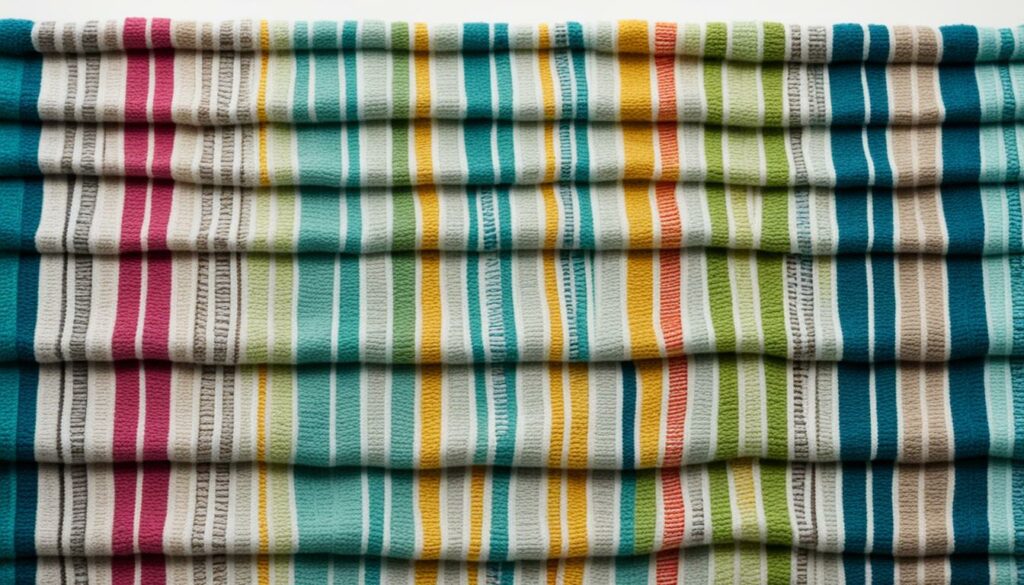
| Scarf Pattern | Yarn Weight | Yardage |
|---|---|---|
| Ribbed Scarf | Worsted | 400 yards |
| Lace Infinity Scarf | Lace | 600 yards |
| Chunky Cable Scarf | Bulky | 800 yards |
Adjusting Yardage for Pattern Variations
If you decide to modify a scarf pattern, whether it’s by changing the width, length, or adding more texture, it’s important to adjust the yardage accordingly. Depending on the specific modifications, you may need to increase or decrease the estimated yardage. To ensure you have enough yarn for your project, always consider the planned modifications and refer back to the original calculation methods.
When making pattern variations such as widening or narrowing the width, keep in mind that a wider scarf will require more yarn, while a narrower one will generally need less. You can estimate the additional or reduced yardage by calculating the difference in width and adjusting it proportionally.
The same applies to modifications in length. If you’re planning to make a longer scarf, you’ll need more yarn, while a shorter scarf will require less. Measure the desired length and compare it to the original pattern to determine the additional or reduced yardage.
Adding more texture, such as cables or lace patterns, can also affect the yardage needed for your scarf. Stitch patterns with a higher level of complexity may consume more yarn. Consider the stitch repeat and the number of rows or rounds needed to achieve the desired texture. You may want to create a gauge swatch with the pattern variation to calculate the yardage more accurately.

By adjusting the yardage for pattern variations, you can ensure that you have enough yarn to complete your modified scarf. It’s always better to have a little extra yarn than to run out in the middle of your project. Take your time to calculate the yardage needed for your specific modifications and enjoy the process of creating a unique and personalized scarf.
Tips for Buying Yarn for Scarves
When it comes to buying yarn for your scarf projects, we have a few helpful tips to ensure a smooth and successful knitting experience. By following these yarn purchasing tips, you can avoid running out of yarn or encountering any unexpected surprises along the way.
Buy a Little More Than the Estimated Yardage
It’s always a good idea to purchase a little extra yarn than the estimated yardage for your scarf. This allows for any variations in knitting tension or if you decide to make modifications to the pattern. Having a bit of extra yarn ensures that you have enough to complete your project without having to worry about running out.
Consider the Fiber Content
When choosing yarn for your scarf, it’s important to consider the fiber content. Different fibers may have different yardage requirements. For example, bulky wool yarn may require less yardage compared to a finer silk yarn. Take a look at the yarn label or consult with your local yarn shop for guidance on the yardage needed based on the specific fiber content you choose.
Check the Dye Lot and Purchase Enough Skeins
Before purchasing yarn for your scarf, it’s crucial to check the dye lot. Dye lots represent the batch in which the yarn was dyed, and slight color variations can occur between different dye lots. To ensure a consistent color throughout your scarf, make sure to purchase enough skeins or balls of yarn from the same dye lot. This helps prevent any noticeable color differences in your finished project.

Remember, buying yarn for your scarf is more than just a shopping task. It’s an exciting opportunity to explore different fibers, textures, and colors to bring your knitting project to life. By applying these tips, you can confidently choose the right yarn, have enough supply, and create a beautiful and cozy scarf that you’ll cherish for years to come.
Making the Most of Your Yarn
When it comes to knitting a scarf, maximizing yarn usage and using leftover yarn is a great way to get creative and reduce waste. By exploring alternate stitch patterns or designs that require less yardage, you can make the most out of every skein of yarn. Additionally, incorporating leftover yarn from other projects can add beautiful stripes or color-block patterns to your scarf.
One technique to consider is alternating between different colors or textures to create a visually appealing and unique scarf. This allows you to use up smaller quantities of leftover yarn while still achieving a stunning result. Whether you choose to combine complementary colors or experiment with contrasting textures, the possibilities are endless!
Another way to maximize yarn usage is to choose stitch patterns that are known for their efficiency. For example, opting for lacework or openwork designs can create a beautifully textured scarf while using less yarn compared to denser stitch patterns.
Embracing Stripes and Color Blocks
Stripes and color blocks are a fantastic way to incorporate leftover yarn into your scarf. By alternating between different colors or even textures, you can create visually striking patterns that catch the eye. Whether you prefer bold and vibrant stripes or subtle and tonal color blocks, this technique allows you to use up smaller quantities of leftover yarn while adding a touch of uniqueness to your scarf.
“Using leftover yarn to add stripes or color blocks not only maximizes yarn usage but also adds a personal touch to your scarf.” – Knitting Enthusiast
Creating a Scrap Yarn Scarf
If you have various oddments of yarn leftover from different projects, why not create a beautiful scrap yarn scarf? This is a fantastic way to combine different colors, textures, and even weights of yarn to make a truly one-of-a-kind piece. Using a simple garter stitch or a basic ribbing pattern, you can seamlessly blend the different yarns together to create a visually interesting and textured scarf.
Demo for Maximizing Yarn Usage
To demonstrate how you can maximize yarn usage and incorporate leftover yarn into your scarf, take a look at this table showcasing different stitch patterns and their estimated yardage:
| Stitch Pattern | Yardage per Inch |
|---|---|
| Garter Stitch | 10 yards |
| Stockinette Stitch | 12 yards |
| Lacework | 8 yards |
| Ribbing | 10 yards |
As shown in the table, opting for stitch patterns like lacework or ribbing can help you achieve a beautiful scarf while using less yarn per inch compared to garter stitch or stockinette stitch. This means you can stretch your yarn further, making it possible to create longer scarves or even use up smaller amounts of leftover yarn.
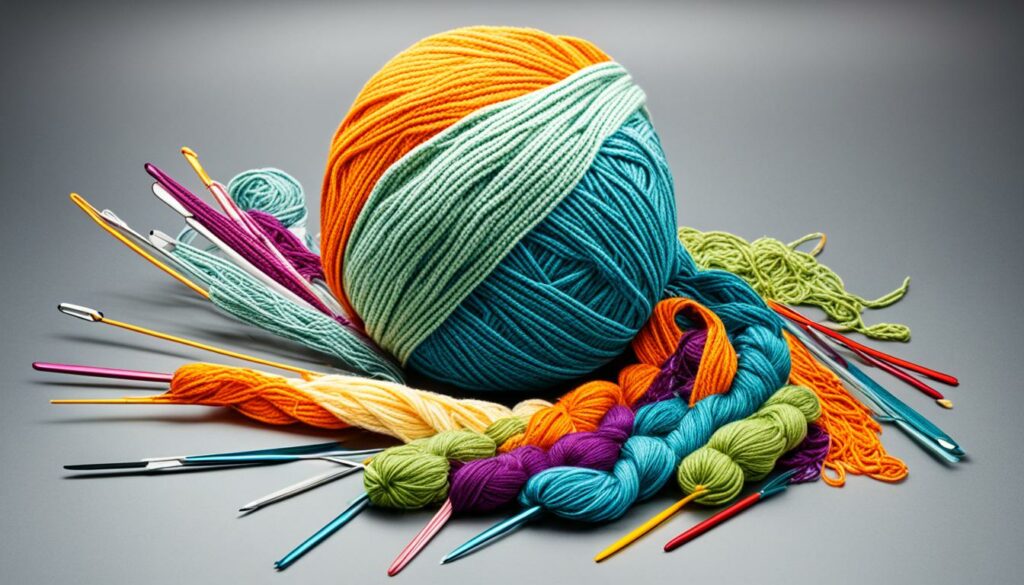
Recommended Scarf Lengths and Widths
The length and width of a scarf are important factors to consider when knitting to ensure both functionality and style. Personal preference and intended use play a significant role in determining the ideal scarf length and width. Here are some recommendations to guide you:
Scarf Length
A standard scarf length typically falls within the range of 60-70 inches. This length allows for versatility in styling, as it can be wrapped around the neck multiple times or left long for a more relaxed look. However, shorter scarves around 50-55 inches in length are also popular for a neat and tidy appearance.
Scarf Width
The width of a scarf can vary depending on individual preference and the desired level of coverage. For a narrower scarf, a width of 6-8 inches is suitable, providing a sleek and lightweight accessory. On the other hand, wider scarves ranging from 10-12 inches offer more warmth and can make a bold fashion statement.
Remember, the length and width of your scarf should be proportionate to your body size and the intended coverage. It’s essential to consider these factors to ensure your scarf not only looks great but also keeps you warm and comfortable.
Now that you have a better understanding of the recommended scarf lengths and widths, you can confidently choose the dimensions that best suit your style and knitting project. Experiment with different lengths and widths to create unique scarves that reflect your personality and meet your specific needs.

| Scarf Length | Scarf Width |
|---|---|
| 50-55 inches | 6-8 inches |
| 60-70 inches | 10-12 inches |
Conclusion
Knitting a scarf can be a fun and rewarding project, but accurately estimating the yardage needed is essential to ensure the successful completion of your scarf. By considering factors such as yarn weight, gauge swatching, and pattern modifications, you can confidently determine the amount of yarn required for your project. Remember to always have a little extra yarn on hand and get creative with any leftover yarn. With the right planning and calculations, you can knit a beautiful scarf that is both stylish and warm.
Summarizing scarf yarn requirements, the key factors to consider are yarn weight, gauge swatching, and pattern modifications. Yarn weight plays a crucial role in determining the amount of yardage needed, with lighter weights requiring less yarn and heavier weights requiring more. Creating a gauge swatch allows you to accurately calculate the number of stitches and rows per inch, resulting in a more precise yarn measurement. Additionally, adjusting yardage for pattern variations and having extra yarn on hand can help you tackle any unexpected modifications and ensure a successful scarf knitting project.
Final thoughts on scarf knitting, remember to enjoy the process and have fun experimenting with different yarns and patterns. Knitting a scarf allows you to express your creativity and create a unique accessory that reflects your personal style. Whether you’re a beginner or an experienced knitter, taking the time to accurately estimate your yarn requirements will enhance your overall knitting experience and result in a beautifully crafted scarf that you can proudly wear or gift to a loved one.
FAQ
How do I determine how much yarn I need for a scarf?
What role does yarn weight play in determining the yardage needed for a scarf?
How can I calculate yarn requirements using a gauge swatch?
What factors can affect the yardage needed for a scarf?
Can you provide examples of yardage requirements for different types of scarves?
How should I adjust the yardage if I modify a scarf pattern?
What should I consider when buying yarn for a scarf project?
How can I make the most of my yarn and prevent wasted leftovers?
What are the recommended lengths and widths for scarves?
-

 Vetted5 months ago
Vetted5 months ago14 Best Personalized Father's Day Gifts for Your Husband – Show Him You Care
-

 Alfresco5 months ago
Alfresco5 months agoAlfresco Stacker Doors: Seamless Indoor-Outdoor Living!
-

 Vetted6 months ago
Vetted6 months ago15 Best EMS Foot Massagers for Neuropathy to Soothe Your Feet
-

 Craft and Textiles7 months ago
Craft and Textiles7 months ago15 Best Places to Buy Appliances for Your Home – Top Retailers Reviewed
-
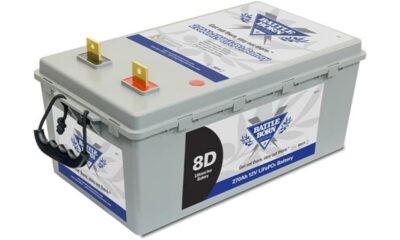
 Vetted5 months ago
Vetted5 months agoBattle Born Batteries Review: Reliable Power Solution
-

 Vetted5 months ago
Vetted5 months agoD-Link Switch Review: Lite Layer 3 Managed Networking
-

 Tableware and Dining Accessories7 months ago
Tableware and Dining Accessories7 months agoWhat Is the Meaning of the Word Tableware
-

 Tableware and Dining Accessories7 months ago
Tableware and Dining Accessories7 months agoWhat Is the Hindi Meaning of Tableware





























